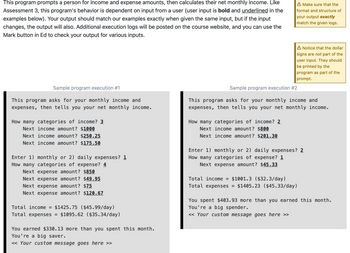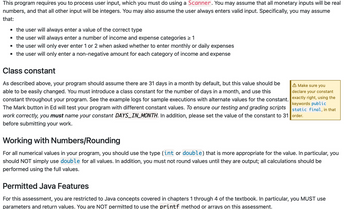
Database System Concepts
7th Edition
ISBN: 9780078022159
Author: Abraham Silberschatz Professor, Henry F. Korth, S. Sudarshan
Publisher: McGraw-Hill Education
expand_more
expand_more
format_list_bulleted
Question
Aq1

Transcribed Image Text:This program prompts a person for income and expense amounts, then calculates their net monthly income. Like
Assessment 3, this program's behavior is dependent on input from a user (user input is bold and underlined in the
examples below). Your output should match our examples exactly when given the same input, but if the input
changes, the output will also. Additional execution logs will be posted on the course website, and you can use the
Mark button in Ed to check your output for various inputs.
Sample program execution #1
This program asks for your monthly income and
expenses, then tells you your net monthly income.
How many categories of income? 3
Next income amount? $1000
Next income amount? $250.25
Next income amount? $175.50
Enter 1) monthly or 2) daily expenses? 1
How many categories of expense? 4
Next expense amount? $850
Next expense amount? $49.95
Next expense amount? $75
Next expense amount? $120.67
Total income = $1425.75 ($45.99/day)
Total expenses = $1095.62 ($35.34/day)
You earned $330.13 more than you spent this month.
You're a big saver.
<< Your custom message goes here >>
A Make sure that the
format and structure of
your output exactly
match the given logs.
How many categories of income? 2
Next income amount? $800
Next income amount? $201.30
A Notice that the dollar
signs are not part of the
user input. They should
be printed by the
program as part of the
prompt.
Sample program execution #2
This program asks for your monthly income and
expenses, then tells you your net monthly income.
Enter 1) monthly or 2) daily expenses? 2
How many categories of expense? 1
Next expense amount? $45.33
Total income = $1001.3 ($32.3/day)
Total expenses = $1405.23 ($45.33/day)
You spent $403.93 more than you earned this month.
You're a big spender.
<< Your custom message goes here >>

Transcribed Image Text:This program requires you to process user input, which you must do using a Scanner. You may assume that all monetary inputs will be real
numbers, and that all other input will be integers. You may also assume the user always enters valid input. Specifically, you may assume
that:
▪ the user will always enter a value of the correct type
▪ the user will always enter a number of income and expense categories > 1
▪ the user will only ever enter 1 or 2 when asked whether to enter monthly or daily expenses
▪ the user will only enter a non-negative amount for each category of income and expense
Class constant
As described above, your program should assume there are 31 days in a month by default, but this value should be
able to be easily changed. You must introduce a class constant for the number of days in a month, and use this
constant throughout your program. See the example logs for sample executions with alternate values for the constant.
The Mark button in Ed will test your program with different constant values. To ensure our testing and grading scripts
work correctly, you must name your constant DAYS_IN_MONTH. In addition, please set the value of the constant to 31 order.
before submitting your work.
A Make sure you
declare your constant.
exactly right, using the
keywords public
static final, in that
Working with Numbers/Rounding
For all numerical values in your program, you should use the type (int or double) that is more appropriate for the value. In particular, you
should NOT simply use double for all values. In addition, you must not round values until they are output; all calculations should be
performed using the full values.
Permitted Java Features
For this assessment, you are restricted to Java concepts covered in chapters 1 through 4 of the textbook. In particular, you MUST use
parameters and return values. You are NOT permitted to use the printf method or arrays on this assessment.
Expert Solution
This question has been solved!
Explore an expertly crafted, step-by-step solution for a thorough understanding of key concepts.
This is a popular solution
Trending nowThis is a popular solution!
Step by stepSolved in 4 steps with 3 images

Knowledge Booster
Learn more about
Need a deep-dive on the concept behind this application? Look no further. Learn more about this topic, computer-science and related others by exploring similar questions and additional content below.Similar questions
- There is a significant divergence between keyword searches performed on websites and those performed in databases. What are the most important distinctions between the two in terms of the ways in which the queries are written and the outcomes that come from doing a query?arrow_forwardHow is Structured Query Language (SQL) distinct from other computer languages?arrow_forwardDirections: Study the examples of MLA format and choose the correct answer to each question. Choose the correctly formatted in- text citation for the article. O (Carson March 2001) O (Carson 135) O (Carson 2001) In The Regis Study Skills Guide, the authors note the importance of environment to a successful study perlod (Walsh and Reisig 10). This MLA citation appears in What type of source is this? O Paraphrase of a online source O Newspaper article O Paraphrase of a printed bookarrow_forward
arrow_back_ios
arrow_forward_ios
Recommended textbooks for you
 Database System ConceptsComputer ScienceISBN:9780078022159Author:Abraham Silberschatz Professor, Henry F. Korth, S. SudarshanPublisher:McGraw-Hill Education
Database System ConceptsComputer ScienceISBN:9780078022159Author:Abraham Silberschatz Professor, Henry F. Korth, S. SudarshanPublisher:McGraw-Hill Education Starting Out with Python (4th Edition)Computer ScienceISBN:9780134444321Author:Tony GaddisPublisher:PEARSON
Starting Out with Python (4th Edition)Computer ScienceISBN:9780134444321Author:Tony GaddisPublisher:PEARSON Digital Fundamentals (11th Edition)Computer ScienceISBN:9780132737968Author:Thomas L. FloydPublisher:PEARSON
Digital Fundamentals (11th Edition)Computer ScienceISBN:9780132737968Author:Thomas L. FloydPublisher:PEARSON C How to Program (8th Edition)Computer ScienceISBN:9780133976892Author:Paul J. Deitel, Harvey DeitelPublisher:PEARSON
C How to Program (8th Edition)Computer ScienceISBN:9780133976892Author:Paul J. Deitel, Harvey DeitelPublisher:PEARSON Database Systems: Design, Implementation, & Manag...Computer ScienceISBN:9781337627900Author:Carlos Coronel, Steven MorrisPublisher:Cengage Learning
Database Systems: Design, Implementation, & Manag...Computer ScienceISBN:9781337627900Author:Carlos Coronel, Steven MorrisPublisher:Cengage Learning Programmable Logic ControllersComputer ScienceISBN:9780073373843Author:Frank D. PetruzellaPublisher:McGraw-Hill Education
Programmable Logic ControllersComputer ScienceISBN:9780073373843Author:Frank D. PetruzellaPublisher:McGraw-Hill Education

Database System Concepts
Computer Science
ISBN:9780078022159
Author:Abraham Silberschatz Professor, Henry F. Korth, S. Sudarshan
Publisher:McGraw-Hill Education

Starting Out with Python (4th Edition)
Computer Science
ISBN:9780134444321
Author:Tony Gaddis
Publisher:PEARSON

Digital Fundamentals (11th Edition)
Computer Science
ISBN:9780132737968
Author:Thomas L. Floyd
Publisher:PEARSON

C How to Program (8th Edition)
Computer Science
ISBN:9780133976892
Author:Paul J. Deitel, Harvey Deitel
Publisher:PEARSON

Database Systems: Design, Implementation, & Manag...
Computer Science
ISBN:9781337627900
Author:Carlos Coronel, Steven Morris
Publisher:Cengage Learning

Programmable Logic Controllers
Computer Science
ISBN:9780073373843
Author:Frank D. Petruzella
Publisher:McGraw-Hill Education